Themed collection Metals in infectious diseases and nutritional immunity

Metals in infectious diseases and nutritional immunity
This editorial introduces the ‘Metals in infectious diseases and nutritional immunity’ themed issue for Metallomics, guest edited by Eric Skaar and Manuela Raffatellu.

Metallomics, 2015,7, 926-928
https://doi.org/10.1039/C5MT90021B
An evolutionary perspective on zinc uptake by human fungal pathogens
A link between environmental pH and fungal zinc uptake strategies? Soil acidity and endemic mycoses in the USA.
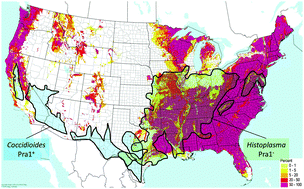
Metallomics, 2015,7, 979-985
https://doi.org/10.1039/C4MT00331D
The role of transition metal transporters for iron, zinc, manganese, and copper in the pathogenesis of Yersinia pestis
Yersinia pestis, the causative agent of bubonic, septicemic and pneumonic plague, encodes a multitude of Fe transport systems.
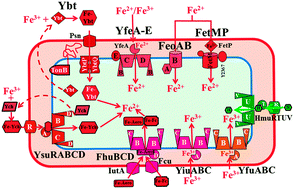
Metallomics, 2015,7, 965-978
https://doi.org/10.1039/C4MT00332B
Bacterial iron–sulfur cluster sensors in mammalian pathogens
We review how iron–sulfur cluster-containing regulators contribute to bacterial pathogenesis through control of gene expression in response to environmental cues.

Metallomics, 2015,7, 943-956
https://doi.org/10.1039/C5MT00012B
Back to the metal age: battle for metals at the host–pathogen interface during urinary tract infection
Uropathogenic Escherichia coli (UPEC) may produce upto four siderophores during urinary tract infection (UTI). Host cells produce lipocalin, calprotectin and ceruloplasmin during UTI. Arrows indicate the direction of metal transport in UPEC during UTI.

Metallomics, 2015,7, 935-942
https://doi.org/10.1039/C4MT00329B
Copper tolerance and virulence in bacteria
Copper (Cu) is an essential trace element for all aerobic organisms.
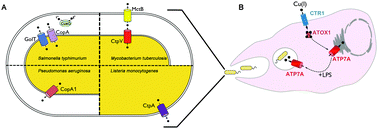
Metallomics, 2015,7, 957-964
https://doi.org/10.1039/C4MT00327F
Copper homeostasis in Mycobacterium tuberculosis
Copper resistance mechanisms in Mtb during infection and sources of host-provided copper are discussed.
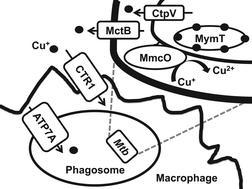
Metallomics, 2015,7, 929-934
https://doi.org/10.1039/C4MT00305E
Diverging roles of bacterial siderophores during infection
Specialization of siderophore function during infection: Salmochelin (Sal) evades Lipocalin 2 (Lcn2) to scavenge iron, Enterobactin (Ent) promotes lung invasion, and Yersiniabactin (Ybt) binds copper for detoxification and zinc for nutrition.
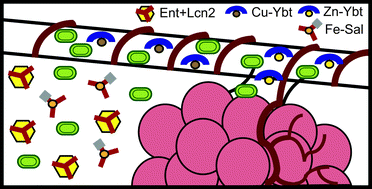
Metallomics, 2015,7, 986-995
https://doi.org/10.1039/C4MT00333K
Contrasting regulation of macrophage iron homeostasis in response to infection with Listeria monocytogenes depending on localization of bacteria
We describe for the first time the changes of iron homeostasis in response to infection of macrophages with Listeria monocytogenes.
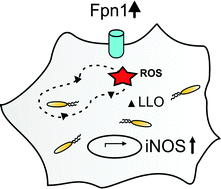
Metallomics, 2015,7, 1036-1045
https://doi.org/10.1039/C4MT00328D
Metal selectivity by the virulence-associated yersiniabactin metallophore system
Metal–yersiniabactin complexes are transported intact through the outer membrane receptor, FyuA, in a TonB-dependent manner in uropathogenic Escherichia coli.
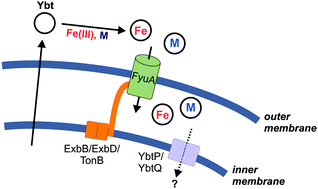
Metallomics, 2015,7, 1011-1022
https://doi.org/10.1039/C4MT00341A
Trace element landscape of resting and activated human neutrophils on the sub-micrometer level
Neutrophils and extracellular traps examined by synchrotron radiation X-ray fluorescence and inductively coupled plasma mass spectrometry.
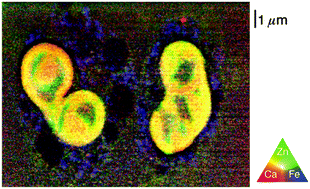
Metallomics, 2015,7, 996-1010
https://doi.org/10.1039/C4MT00346B
The capability of Pseudomonas aeruginosa to recruit zinc under conditions of limited metal availability is affected by inactivation of the ZnuABC transporter
Zn acquisition in Pseudomonas aeruginosa.
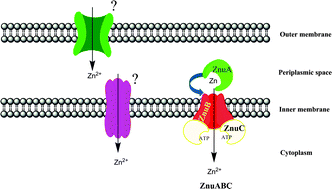
Metallomics, 2015,7, 1023-1035
https://doi.org/10.1039/C5MT00017C
About this collection
This themed issue, Guest Edited by Professor Eric Skaar and Professor Manuela Raffatellu, showcases some of the latest developments in understanding the roles of metals in infectious diseases and nutritional immunity. All articles are free to access until 31 July 2015.